Propositional Logic Examples With Answers
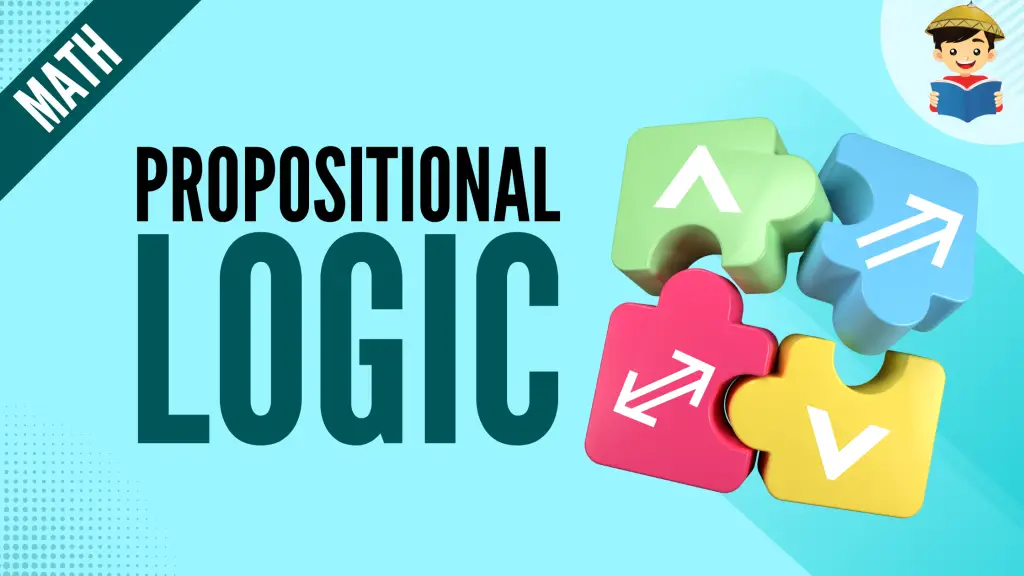
Since the ancient Greek civilizations, logic has been of utmost interest to philosophers and thinkers. Logic refers to using valid reasoning and proper thinking to arrive at a helpful conclusion.
Thinking logically is one ability that separates humans from other creatures on this planet, as we can use the information around us to reason and arrive at a particular conclusion.
But how does logic relate to mathematics? Why do we have to study it?
Logic is one of the foundations of mathematics. When solving mathematical problems, we provide logical reasoning for each step using specific mathematical principles. Furthermore, we can also use logic to identify the truthfulness of a statement given certain premises.
This review will discuss the most basic approach to studying logic – using propositional logic examples with answers.
Click below to go to the main reviewers:
Table of Contents
What Is a Proposition?
Our study of logic will start with statements called “propositions.” A proposition is a statement, precisely a declarative sentence, which can be true or false.
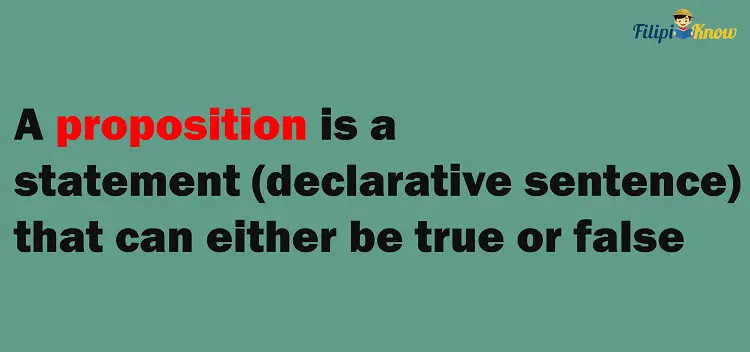
For instance, the statement “Red is a primary color” is an example of a proposition because this statement is a declarative sentence. Furthermore, we can identify the truthfulness of this statement since it states true information (red, blue, and yellow are the primary colors).
Another example is the statement, “Manuel A. Roxas is the fifth president of the Republic of the Philippines,” as it can either be true or false and is a declarative sentence.
The statement “Cats have wings” is also an example of a proposition because this statement is a declarative sentence. Although this statement is false (of course, cats don’t have wings!), we can still identify whether it is true or false, making it a proposition.
Likewise, “The sum of 1 and 3 is 4” is an example of a proposition. We can identify whether this statement is true or false and is also a declarative sentence.
Note that a statement is not a proposition if we cannot identify whether it’s true or false.
For example, the statement “Can you get me a glass of water?” is not a proposition since the given statement is not a declarative sentence (it is an interrogative sentence). Furthermore, we cannot determine whether the sentence is true or false since it doesn’t tell us any information.
Sample Problems: Which of the following is/are proposition(s)?
a) Two raised to five is 32
b) The square of a negative number is positive
c) 3 + 6 = 9
d) 3 + x = 9
Solution:
a) This statement is a proposition since it is a declarative sentence, and we can identify whether it is true or false.
b) This statement is also a proposition since it is a declarative sentence, and we can identify whether it is true or false.
c) This equation is a proposition. Notice that we can write 3 + 6 = 9: “Three increased by 6 equals 9.” This statement is a declarative sentence, and we can identify whether the statement is true or false.
d) This is not a proposition since we cannot verify whether the statement is true or false unless a value of x is specified.
The Truth Value of a Proposition
We say that the truth value of a proposition is “true” or “T” if the statement is factual. Otherwise, the statement has a truth value of “false” or “F.”
For instance, “Red is a primary color” has a truth value of TRUE or T.
Note that a proposition has one truth value only. This means that there’s no proposition that is both true and false at the same time. This also implies that once a statement is already known to be false, it follows that it is false.
For instance, the statement “Red is a primary color,” as we know, has a truth value of “TRUE.” it is already impossible for this statement to have a truth value of FALSE since every proposition has one truth value only.
Sample Problems: Identify the truth value of the following propositions.
- The square of a number is always positive.
- The sum of two even numbers is always an even number.
Solution:
- This proposition’s truth value is FALSE since it is not the case that the square of a number is always positive. For instance, when you square the number 0: 02 = 0 x 0 = 0. Notice that the result is not a positive number. 0 is neither positive nor negative since it is the basis to define the sign of the number. This is why the set of numbers {0, 1, 2, 3, …} is called nonnegative numbers, not positive ones. Hence, it is not true that the square of a number is always positive.
- This proposition’s truth value is TRUE. You will always get an even number when you add two even numbers, such as 2 + 8 = 10, 16 + 22 = 38, and so on.
Propositional Statements Are Expressed As Equations, Expressions, Inequalities, etc.
Propositional statements sometimes appear not in the form of an English sentence. There are some instances when they appear as symbols or mathematical expressions.
For instance, 5 + 1 = 6 is a propositional statement, although it is not written as an English declarative sentence. This is because we can identify the truth value of this statement. 5 + 1 = 6 is a true statement.
On the other hand, x + 1 = 6 is not a proposition since we cannot identify its truth value unless we specify the value for x. Furthermore, note that the statement’s truth value depends on the value of x we will use. For instance, if we let x = 0, we know the statement will be false since 0 + 1 ≠ 6. On the other hand, if we let x = 5, the statement becomes true since 5 + 1 = 6.
Propositional Variables: Symbolizing Propositions
We can write propositions as symbols or variables so that we don’t need to write them at full length. We usually use lowercase or uppercase Roman letters to represent a particular proposition. For instance, the proposition “Red is a primary color” can be represented by the variable p. Therefore, in this case, proposition p stands for or represents the proposition “Red is a primary color.”
The variables used to represent a particular proposition are called propositional variables. They are a valuable shorthand way of expressing propositions as it saves time and space, especially when dealing with too complex or compound propositions.
Complex Propositions and Connectives
If a proposition is composed of two or more propositions, we call that proposition a complex proposition.
For example, the proposition “Red is a primary color and cats have wings” is an example of a complex proposition since it is composed of two “smaller” propositions.
The first “smaller” proposition is “Red is a primary color,” while the second is “Cats have wings.”
Note that the propositions “Red is a primary color” and “Cats have wings” are formed by connecting them using the word “and.” The word “and” is an example of a connective. A connective combines two or more propositions to form a complex proposition.
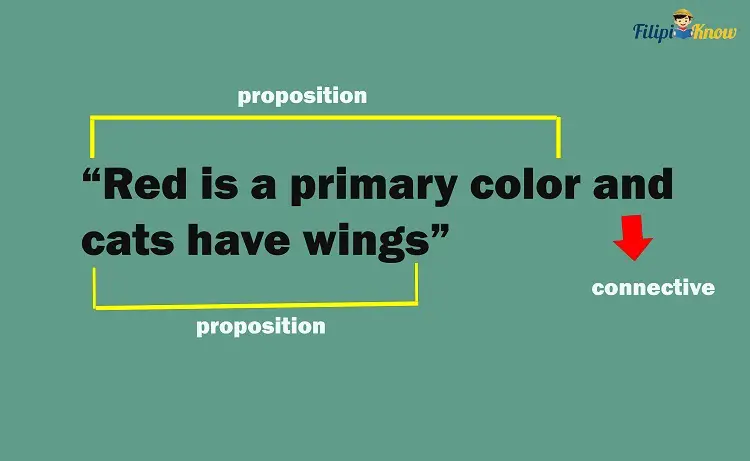
To write the complex proposition more precisely, let p be “Red is a primary color” and let q be the proposition “Cats have wings.” The symbol “∧” is used to represent the connective “and.”
Hence, we can rewrite the proposition “Red is a primary color and cats have wings” using the symbols we have set: p ∧ q.
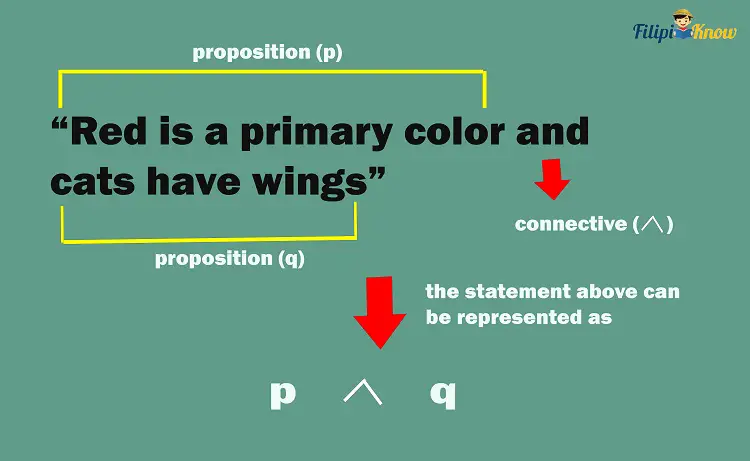
Different connectives combine propositions to form complex propositions. Below is the list of the connectives and their respective symbols:
| Connective | Symbol |
| and | ∧ |
| or | ∨ |
| not | ¬ |
| implies | ⇒ |
| If and only if (iff) | ⇔ |
In the succeeding sections, we will discuss the types of complex propositions formed using these connectives.
1. Conjunctions
If two propositions are connected by the word “AND” to form a complex proposition, then we have a conjunction.
If p and q are propositions, then the conjunction of p and q is written as p ∧ q. The symbol “∧” represents the word “AND” that connects the propositions p and q.
For example, let p be the proposition “Snakes are reptiles,” and q be the proposition “7 is an odd number.” Then, the conjunction of p and q or p ∧ q should be “Snakes are reptiles AND 7 is an odd number”.
Sample Problems: Define the conjunction of the following given propositions:
- Define m ∧ n if m is “Tomorrow is Saturday” and if n is the proposition “Physics is a branch of Science.”
- Define a ∧ b if a is the proposition “Earth is a terrestrial planet” and b is the proposition “-3 is a positive number.”
- Define p ∧ q if p is the proposition “9 is a positive number” and q is the proposition “9 is an odd number.”
Solution:
- The conjunction m ∧ n is “Tomorrow is Saturday and Physics is a branch of Science.”
- The conjunction a ∧ b is “Earth is a terrestrial planet and -3 is a positive number.”
- The conjunction p ∧ q is “9 is a positive number and 9 is an odd number.” However, note that this statement or conjunction can be written more concisely: “9 is a positive number and an odd number.” But, the most concise way to write the conjunction is “9 is a positive odd number.”
Truth Value of a Conjunction
How can we determine whether the conjunction we constructed is true or false? We refer to the truth values of the respective propositions that composed the conjunction to identify it.
“A conjunction p ∧ q has a truth value of TRUE if and only if p and q are both true.”
The statement above tells us that a conjunction is stating a piece of true information if both of the propositions that composed it are also true. This implies that if at least one of the propositions of the conjunction is false, then the conjunction becomes false.
Consider the conjunction: “7 is a prime number, and 9 is an odd number.”
The propositions that compose the conjunction above are:
- 7 is a prime number; and
- 9 is an odd number
Note that both of these propositions are true. 7 is a prime number since its only factors are one and itself, and 9 is an odd number since it is not divisible by 2.
Since both propositions of the given conjunction are true, the entire conjunction is true. Hence, the truth value of the conjunction “7 is a prime number, and 9 is an odd number” is also true.

Now, let P be the proposition, “Red is a primary color,” and let Q be the proposition, “Cats have wings.” What is the truth value of P ∧ Q?
The expression “P ∧ Q” refers to the conjunction of the propositions P and Q. If both P and Q are true, the conjunction P ∧ Q is also true.
Proposition P is true since red is indeed a primary color. On the other hand, Q is false since cats do not have wings. As you can see, one of the propositions of the conjunction is false. Recall that for a conjunction to be true, both propositions that compose it must also be true. Since proposition Q is false in P ∧ Q, it implies that the conjunction P ∧ Q must be false.
Hence, the conjunction P ∧ Q or “Red is a primary color and cats have wings” is false.
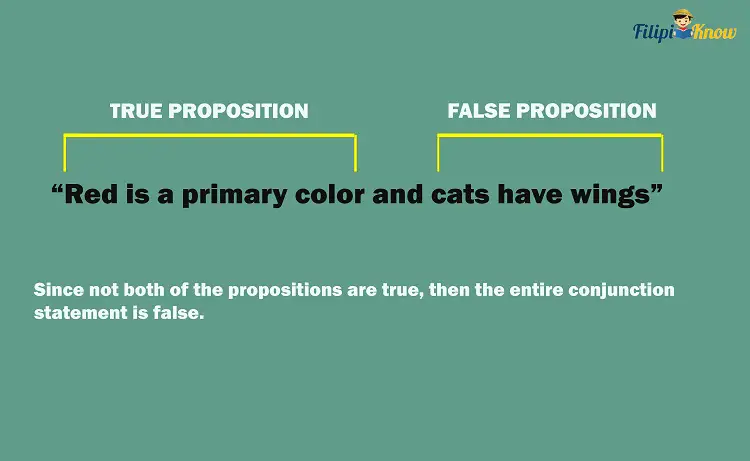
Sample Problem 1: Let p be the proposition “All three-sided polygons are triangles” and let q be the proposition “All right angles are congruent.” What is the truth value of p ∧ q?
Solution: Since p ∧ q indicates the conjunction of the propositions p and q, p ∧ q will be true if both p and q are true.
Proposition p is true since the definition of a triangle states that it is a three-sided polygon. On the other hand, q is also true since all right angles have a measure of 90 degrees, implying that all have equal measures (and, thus, congruent). Since both p and q are true, the conjunction p ∧ q must also be true.
Sample Problem 2: Is the conjunction “2 is an even number and a prime number” true or false?
Solution: The first proposition of the conjunction is “2 is an even number,” while the second is “2 is a prime number.” Both propositions are true. Hence, the conjunction “2 is an even number and a prime number” must also be true.
Sample Problem 3: Identify the truth value of m ∧ n if m is the proposition “-5 is greater than 0,” and n is the proposition “the square root of a negative number is a real number.”
Solution: The truth value of m ∧ n is true if both m and n are true.
Proposition m is false since -5 is less than 0. Meanwhile, n is false since the square root of a negative number is an imaginary number and not a real number. Since both statements are false, then m ∧ n is false.
2. Disjunction
A disjunction is a complex proposition formed by connecting two or more propositions using the word “OR.” The symbol used for OR is “∨.”
If p and q are propositions, the disjunction of p and q is written as “p ∨ q” (read as “p or q”).
For instance, consider proposition p “Cats are mammals,” and proposition q “Chickens are birds.” The disjunction of the propositions p and q or “p ∨ q” is “Cats are mammals or chickens are birds.”
Sample Problem 1: Let m be the proposition “Mozart is a classical composer” and n be the proposition “Newton is a physicist.” What is m ∨ n?
Solution: The expression m ∨ n indicates the propositions m and n disjunction. Hence, m ∨ n must be “Mozart is a classical composer, or Newton is a physicist.”
Sample Problem 2: Form the disjunction of the propositions “5 is an odd number” and “3 is an even number.”
Solution: The disjunction of the propositions is “5 is an odd number, or 3 is an even number.”
Truth Value of a Disjunction
The truth value of a disjunction is TRUE if at least one of the propositions that compose it is true. In other words, if one of the propositions is already true, the entire disjunction is true regardless of the truth value of the other proposition.
“A disjunction p ∨ q is true if at least one of p and q is true.”
The statement above tells us that for a disjunction to be true, it is sufficient that one of the propositions that compose it is true. In other words, disjunction p ∨ q is true if:
- p is true, and q is false
- p is false, and q is true
- p and q are both true
This also implies that a disjunction is false if and only if both of the propositions p and q are false.
Don’t be confused too much about the truth value of a disjunction. The simplest way to identify its truth value is to identify whether one of the disjunction’s propositions is true. If one of the propositions is already true, the disjunction is true regardless of the truth value of the other proposition.
Sample Problem 1: Identify the truth value of the disjunction “5 is an odd number or an even number.”
Solution: The given disjunction has the following propositions:
- 5 is an odd number
- 5 is an even number
Proposition 1 is true since 5 is not divisible by 2. Since one of the propositions of the disjunction is already true, the entire disjunction is already true regardless of the truth value of proposition 2.
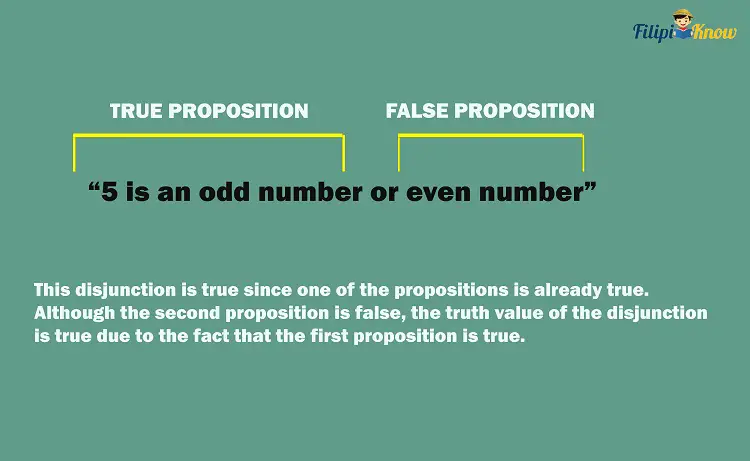
Sample Problem 2: Let p be the proposition “The square of 7 is 36” and let q be the proposition “9 is an integer.” What is the truth value of p ∨ q?
Solution: p ∨ q implies the disjunction of the propositions p and q. For p ∨ q to be true, at least one of p and q must be true.
Proposition p is false since the square of 7 is not 36 but 49 (72 = 7 x 7 = 49). Does this mean that the disjunction p ∨ q is already false? No, since we haven’t considered the truth value of proposition q yet.
Proposition q is true since 9 is indeed an integer. We have now shown that one of the propositions of p ∨ q is true. Since a disjunction is true if at least one of its propositions is true, then p ∨ q must be true.
Although we discovered proposition p is false earlier, it doesn’t matter anymore since q is true. Note that we only need one true proposition of the disjunction to conclude that the entire disjunction is true. Hence, the truth value of the disjunction in this example is true.
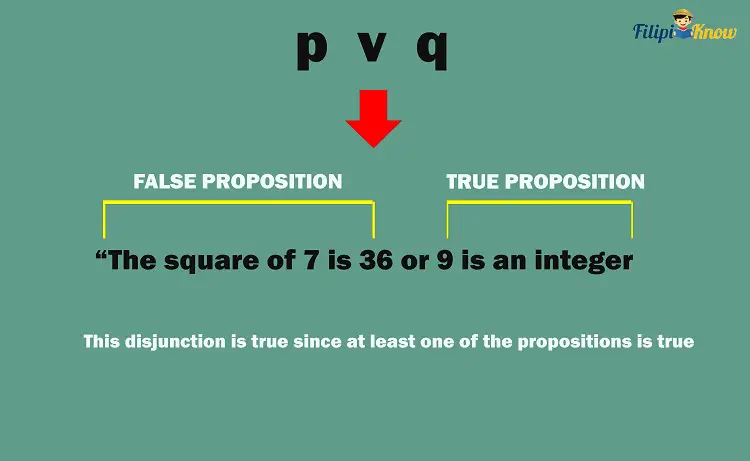
Sample Problem 3: What is the truth value of “8 is a multiple of 5 or less than 6”?
Solution: We can dissect the given disjunction into propositions:
- 8 is a multiple of 5
- 8 is less than 6
Proposition 1 is false since 8 is not a multiple of 5 (8 is a multiple of 4 instead). Meanwhile, proposition 2 is also false since 8 is not less than 6 (it is 6 that is less than 8). Since both propositions of the disjunction are false and none of its propositions are true, then it follows that the disjunction is false.
The answer for this example is false.
From our previous example, you might have noticed that a disjunction is false if both propositions that compose it are false.
3. Negation of a Proposition
The negation of a proposition is the “opposite” of the proposition. For instance, negating “Dino is happy” is just “Dino is not happy.”
Note that simply adding the word “not” forms the negation of a proposition (but this is not the only way to construct the negation of a proposition).
Formally, the negation of the proposition p is written as ∿p or ¬p (read as “not p”).
Sample Problems: Form the negation of the following propositions.
- French is a European language
- Cats have wings
- 7 is an even number
- π is a rational number
Solution:
- French is not a European language
- Cats do not have wings
- 7 is not an even number (or “7 is an odd number”)
- π is not a rational number (or “π is an irrational number”)
Truth Value of the Negation of a Proposition
The truth value of the negation of a proposition is the opposite of the truth value of the proposition.
“If proposition p is true, then ∿p is false. Similarly, if proposition p is false, then ∿p is true.”
Sample Problem 1: What is the truth value of the negation of “7 is an even number”?
Solution: The proposition “7 is an even number” is false since 7 is an odd number. This means that the negation of the proposition must be true.
Sample Problem 2: Let j be the proposition “All numbers greater than 100 are three-digit numbers.” What is the truth value of ∿j?
Solution: The symbol ∿j indicates the negation of proposition j. Proposition j is false since not all numbers greater than 100 are three-digit numbers. For instance, 1000 is greater than 100 and has four digits. For this reason, j is false. Since j is false, then its negation ∿j must be true.
4. Conditional Statements or Logical Implications (“If and Then” Statements)
Some propositions are related using a conditional statement or more commonly known as “If and then” statements. These are among the most common statements you might have encountered in mathematics.
For instance, “If -2 is a negative number, then -2 is less than 0” is an example of a conditional or “If and then” statement. Note that the propositions that compose this statement are:
- -2 is a negative number
- -2 is less than 0
Formally, if p and q are propositions, then the conditional of p and q is written as “p ⇒ q” (read as “p implies q” or “If p then q”).
Return to our conditional statement, “If -2 is a negative number, then -2 is less than 0.” The first proposition of a conditional statement is called the hypothesis, while the second is called the conclusion. Hence, in the example conditional statement, “-2 is a negative number” is the hypothesis, and “-2 is less than 0” is the conclusion.
In a conditional statement, the conclusion is the logical consequence of the hypothesis.
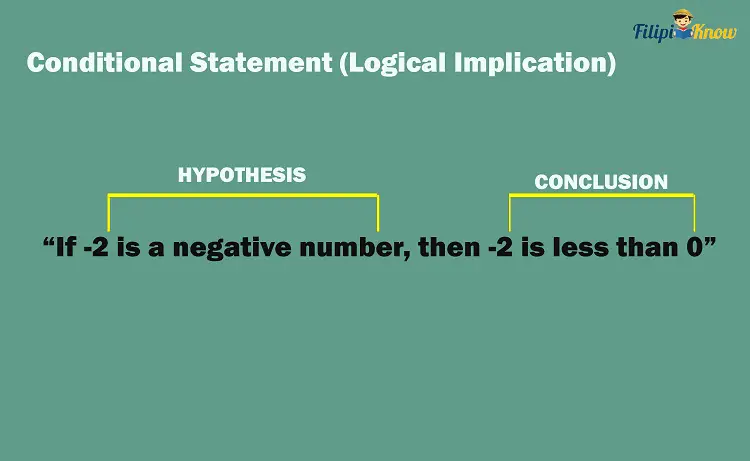
Sample Problems: Construct a conditional statement using the given hypothesis and conclusion:
- Hypothesis: Abel is a high school student
Conclusion: Abel is studying algebra
- Hypothesis: The sum of the interior angles of a polygon is 180 degrees
Conclusion: The polygon is a triangle
Solution:
- “If Abel is a high school student, then he is studying algebra.”
- “If the sum of the interior angles of a polygon is 180 degrees, then the polygon is a triangle.”
Sometimes, conditional statements do not appear with “If” and “then.”
For instance, the statement “The divisibility of 8 by 2 implies that it is an even number” is also a conditional statement even if the words “If” and “then” are absent. By intuition, we can deduce that the hypothesis of the statement is “The divisibility of 8 by 2,” and the conclusion is “8 is an even number.” The reason behind this is that the statement implies that the second proposition, “8 is an even number,” is a consequence of the first proposition, “Divisibility of 8 by 2 (or 8 is divisible by 2).
Truth Value of a Conditional Statement or Logical Implication
It is quite tricky to identify whether a conditional is true or false. A conditional statement is true if at least one of these indicators occurs:
- Both hypothesis and conclusion are true
- The hypothesis is false, and the conclusion is true.
- Both hypothesis and conclusion are false
If you are having a difficult time remembering the three indicators above, you can use this indicator instead:
A conditional statement will be false if and only if the hypothesis is true and the conclusion is false. Otherwise, the conditional statement is true.
The statement above also implies that once the hypothesis of a logical statement is already false, the logical implication is now true regardless of the truth value of the conclusion.
Sample Problem 1: Determine the truth value of this statement: “If 9 is divisible by 3, then 32 = 9.”
Solution: Note that the hypothesis (9 is divisible by 3) and the conclusion (32 = 9) are true. Since a logical implication will be false only if the hypothesis is true and the conclusion is false, then the logical implication above must be true.
Thus, the answer is true.
Sample Problem 2: Is the conditional statement “If 25 is a multiple of 9, then 25 is less than 1” true or false?
Solution: The hypothesis “25 is a multiple of 9” is false. Now, note that a logical implication will be false only if the hypothesis is true and the conclusion is false. Since we have already identified that the hypothesis is already false, then regardless of what will be the truth value of the conclusion, the logical implication will be true.
Thus, the conditional statement above is true.
Sample Problem 3: Let p be the proposition “0 is a whole number” and q be the proposition “0 is less than -1.” What is the truth value of p ⇒ q?
Solution: Proposition p, the hypothesis of the logical implication, is true since 0 is an element of the set of whole numbers. On the other hand, proposition q is false since 0 is greater than -1.
So, we have a true hypothesis and a false conclusion. Note that a logical implication is false if and only if its hypothesis is true and its conclusion is false. Therefore, the truth value of p ⇒ q is false.
5. Biconditional Statements
A biconditional statement connects two propositions using “if and only if.”
For instance, “A polygon is a triangle if and only if it has three sides” is an example of a biconditional statement.
The biconditional statement of p and q is written as p ⇔ q or p iff q (read as “p if and only if q”).
Here are some biconditional statements:
(a) Proposition p: The Earth is a terrestrial planet
Proposition q: The Earth is in the solar system
p ⇔ q: The Earth is a terrestrial planet if and only if it is in the solar system.
(b) Proposition p: π is an irrational number
Proposition q: π < 0
p ⇔ q: π is an irrational number if and only if it is less than 0.
Truth Value of a Biconditional Statement
A biconditional statement is true if and only if both of the propositions have the same truth value. Otherwise, the statement is false.
This implies that a biconditional statement is true if both of the propositions are true or both of them are false.
A biconditional statement p ⇔ q is true if both p and q are true or both p and q are false.
Sample Problems: What is the truth value of the biconditional statements below?
(a) The Earth is a terrestrial planet if and only if it is in the solar system.
(b) 2 is an odd number if and only if it is less than 0.
(c) Manila is the capital of the Philippines if and only if Manila is not in the Philippines
Solution:
(a) Both of the propositions in the statement are true (Earth is a terrestrial planet and is in the solar system). Hence, the biconditional statement is true.
(b) Both statements’ propositions are false (2 is not odd and should be greater than 0). The biconditional statement is true since the propositions have the same truth value.
(c) The first proposition is true (Manila is the capital of the Philippines), while the second proposition is false (Manila is definitely in the Philippines). Since the propositions differ in truth value, the biconditional statement is false.
Summary of Complex Propositions: Conjunction, Disjunction, Negation, Conditional Statement (Logical Implication), and Biconditional
We summarize all the vital information related to complex propositions in the table below:
| Type | How to write in symbols | Truth Value |
| Conjunction of p and q | p ∧ q | p ∧ q is true if and only if both p and q are true. |
| Disjunction of p and q | p ∨ q | p ∨ q is true if and only if at least one of p and q is true. |
| Negation of p | ∿p | If p is true, then ∿p is false, and vice versa. |
| p conditional of q | p ⇒ q | p ⇒ q is false if and only if p is true and q is false. Otherwise, the implication is true. |
| Biconditional of p and q | p ⇔ q or p iff q | p ⇔ q is true if and only if p and q have the same truth values. |
Sample Problems: Let p be the proposition “-17 is a rational number” and let q be the proposition “17 < 0.” Identify the truth value of the following:
- p ∨ q
- p ∧ q
- ∿q
- p ⇒ q
- p ⇔ q
- q ⇒ p
Solution:
- Proposition p is true since -17 is a rational number (integers are rational numbers). On the other hand, proposition q is false since 17 should be greater than 0. Note that the disjunction p ∨ q is true if at least one of the propositions is true. The disjunction is true since we already have one true proposition (proposition p).
- The conjunction p ∧ q is true if both p and q are true. We already determined in item 1 that p is true while q is false. For this reason, the conjunction must be false.
- We already identified that q is a false statement. We take the opposite of the truth value of ∿q to obtain the truth value of q. Since q is false, then ∿q must be true.
- In p ⇒ q, the hypothesis is proposition p, while the conclusion is proposition q. Recall that we have already discovered that proposition p is true while proposition q is false. A logical implication is false if and only if the hypothesis is true and the conclusion is false. For this reason, the implication p ⇒ q is false.
- A biconditional statement p ⇔ q is true if both p and q have the same truth value. However, we have already identified from item 1 that p is true while q is false. This means that the propositions have different truth values. For this reason, the biconditional is false.
- For this item, we have q as the hypothesis of the logical implication and p as the conclusion (opposite of item 4). Recall that q is false. If you can remember, if the hypothesis of a logical implication is already false, then the logical implication will be true regardless of the truth value of the conclusion. Since q is the hypothesis in this case and is false, then the logical implication in this item is true.
Combining Complex Propositions
What if we combine the complex propositions we have learned in the previous sections? Let’s say we combine a conjunction with a conditional (or logical implication) or a biconditional with a disjunction.
Consider the following propositions:
- Let p be the proposition “Merry has a Persian cat.”
- Let q be the proposition “Merry is a college student.”
- Let r be the proposition “Merry is a responsible citizen.”
Can you define the statement represented by p ∧ q ⇒ r?
Notice that p ∧ q ⇒ r involves two connectives: One is the conjunction of p and q, while the other is a conditional between the conjunction of p and q and proposition r.
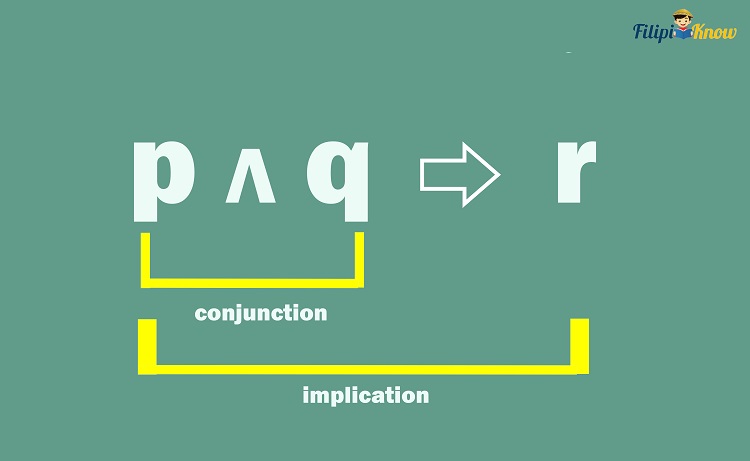
To form the statement represented by p ∧ q ⇒ r, we do it individually.
We first define the conjunction p ∧ q. The statement should be, “Merry has a Persian cat and a college student.
Now that we have written the conjunction let us write the entire conditional statement. If you look again, the hypothesis in p ∧ q ⇒ r is p ∧ q while the conclusion is r. Therefore, we can add if before the statement represented by p ∧ q and add then before the proposition r:
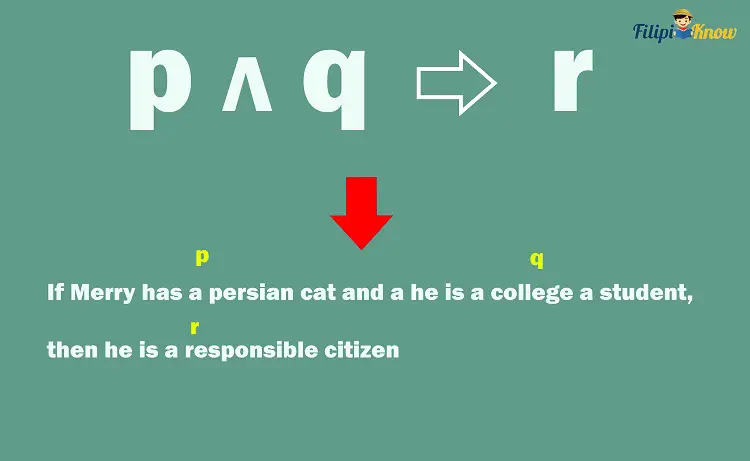
Hence, p ∧ q ⇒ r represents the statement, “If Merry has a Persian cat and he is a college student, then he is a responsible citizen.”
Sample Problem 1: Proposition p is “19 and 20 are consecutive numbers,” proposition q is “19 is less than 20,” and proposition r is “19 and 20 have no common factor.” Using p, q, and r, how will you express the statement: “19 is less than 20 if and only if they are consecutive numbers or have no common factor”?
Solution: Let us start by analyzing the statement: “19 is less than 20 if and only if they are consecutive numbers or have no common factor.”
The word “if and only if” implies that we have a biconditional statement. Thus, we should have two sides in our final answer.
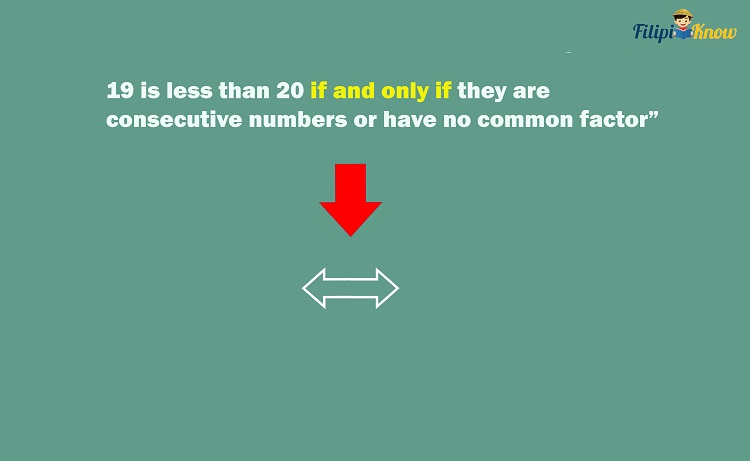
The statement “19 is less than 20” must be on the left side of the double arrow. Since this statement is represented as q, then we have q on the left side.
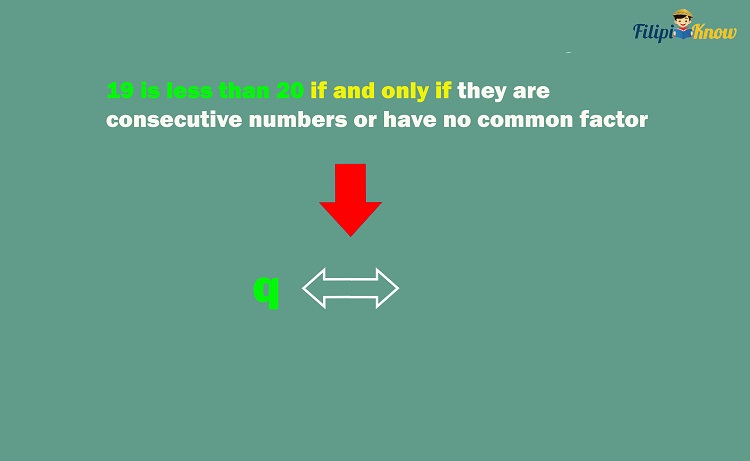
Now, what are we going to put on the right side? We must put the statement “they are consecutive numbers or have no common factor.” Note that the pronoun “they” here refers to 19 and 20.
The word OR signals us that the statements “they (19 and 20) are consecutive numbers” and “19 and 20 have no common factor” must form a disjunction. Since the statements are represented by p and r, we have p ∨ r. This expression is what we are going to write on the right side.
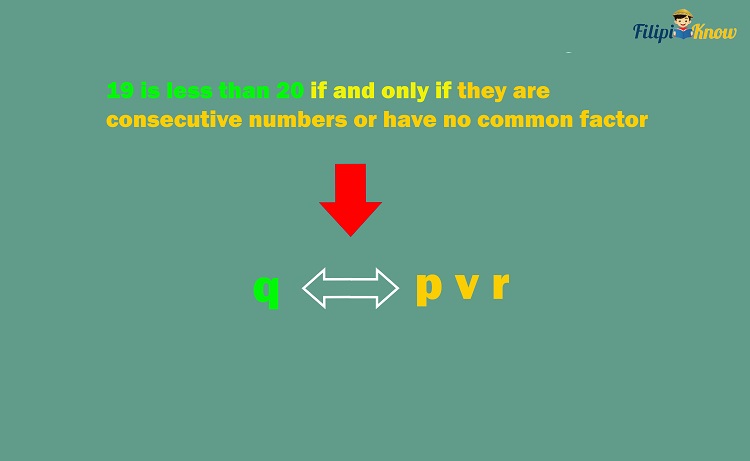
The final answer must be q ⇔ p ∨ r.
Sample Problem 2:
- Let p be the proposition “June 15 is a sunny day.”
- Let q be the proposition “Leo visits his friend.”
- Let r be the proposition “Leo bought a new videogame.”
Write the statement, “If Leo does not visit his friend, then he bought a new video game, and June 15 is not a sunny day,” using the propositional variables p, q, and r.
Solution:
Let us do the translation one by one.
We have an “If and then” statement, so we expect a conditional statement (logical implication) here with a hypothesis and a conclusion.
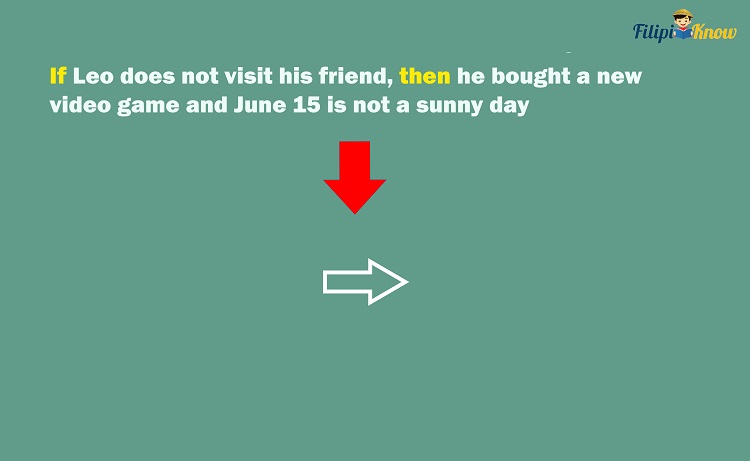
Let’s determine the hypothesis (the one we will put on the left of the arrow sign) and the conclusion (the one on the right).
The hypothesis is “Leo does not visit his friend.” Note that this proposition is the opposite of the statement represented by q. Therefore, we have the negation of q or ∿q. This means we must put ∿q on the left of the arrow sign.
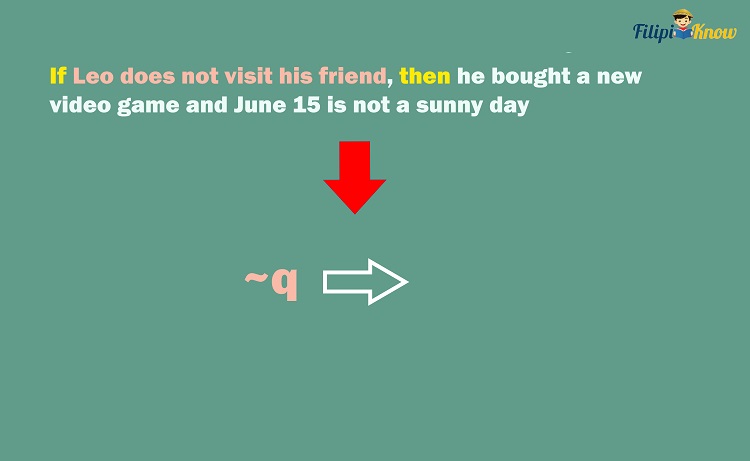
On the right side, we need to put the conclusion of the conditional statement, which is “he bought a new video game, and June 15 is not a sunny day.” The word “AND” signals us that we have the conjunction of the statements “Leo bought a new video game” and “June 15 is not a sunny day.” These statements are represented by r and ∿p, respectively. So, we have r ∧ ∿p. This is what we will put on the right of the arrow.
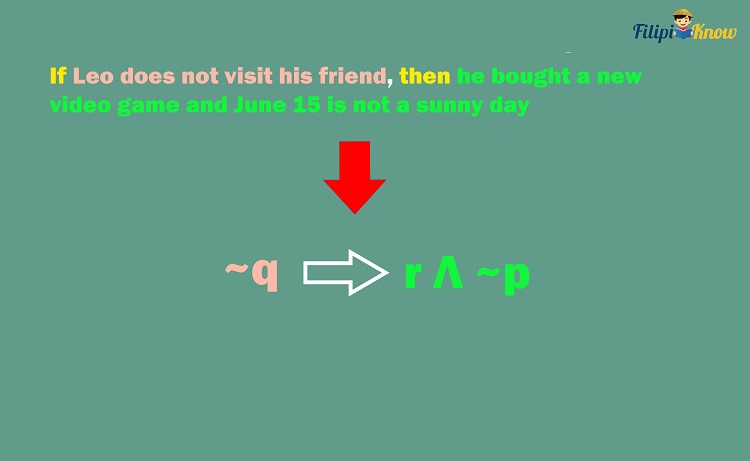
Thus, the final answer must be ∿q ⇒ r ∧ ∿p
Identifying the Truth Value of a Statement Composed of Different Complex Propositions
Consider this statement: “If π and 0 are nonnegative integers, then their sum is also nonnegative.”
Let us break down the statement into “smaller” propositions that compose it.
- The first proposition is “π is a nonnegative integer.” Let us represent this proposition as p.
- The second proposition is “0 is a nonnegative integer.” Let us represent this proposition as q.
- The third proposition is “Their (π and 0) sum is nonnegative.” Let us represent this proposition as r.
If we translate the statement “If π and 0 are nonnegative integers, then their sum is also nonnegative” using the propositional variables p, q, and r, we have:
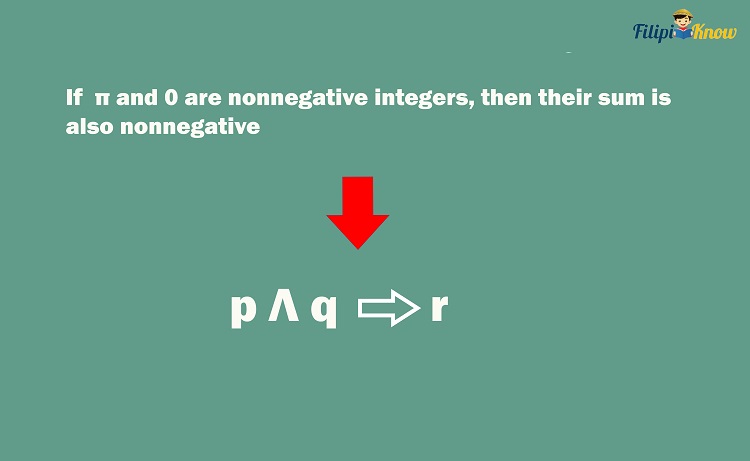
Hence, we have p ∧ q ⇒ r.
Now, what is the truth value of p ∧ q ⇒ r?
First, we need to identify the individual truth value of the propositional variables p, q, and r:
p is a true proposition since π is a positive integer. q is also a true proposition because 0 is also nonnegative. Lastly, r is also a true proposition since the sum of π and 0 is π which is also nonnegative.
Now, let us identify the truth value of p ∧ q ⇒ r.
Let us start with p ∧ q. This conjunction is true if both p and q are true. Since we have already shown that p and q are true, then p ∧ q is a true conjunction.
Let us now identify the truth value of p ∧ q ⇒ r. We have already mentioned earlier that the left side, p ∧ q, is a true proposition, and its right side, (r), is also true. This means the logical implication p ∧ q ⇒ r should also be true.
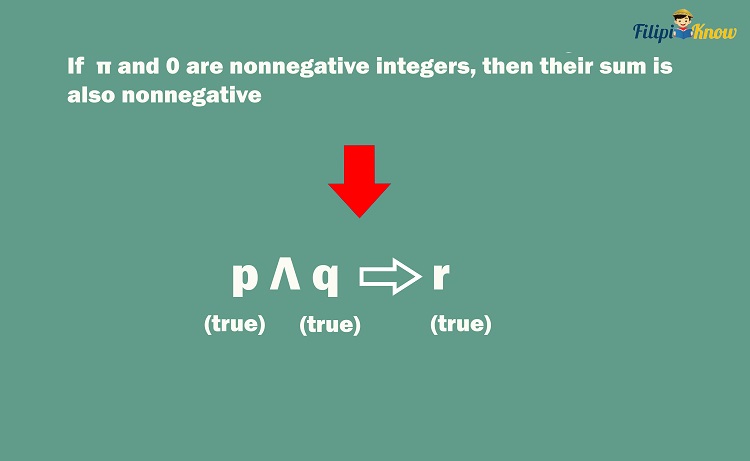
Therefore, p ∧ q ⇒ r is a true statement.
Sample Problem:
- Let p be the proposition “The diameter is twice as long as the circle’s radius.”
- Let q be the proposition “The diameter is a chord of a circle.”
- Let r be the proposition “The radius is a chord of a circle.”
What are the truth values of the following?
- ∿ q ∨ ∿ r ⇒ ∿ p
- p ∧ ∿ r ⇔ ∿ q
Solution:
It will be much easier first to identify each proposition’s truth value.
- Proposition p is true (recall that twice the length of the radius of a circle is equal to the circle’s diameter).
- Proposition q is true (a chord is a segment of a circle where the endpoints are points on the circle; the diameter of a circle satisfies this condition).
- Proposition r is false (the radius has an endpoint that is not on the circle, which disqualifies it as a chord of the circle).
Using the individual truth values of each proposition above, let us answer item 1:
(1) ∿ q ∨ ∿ r ⇒ ∿ p
Since we have shown that q is a true statement, its negation, ∿ q , must be false. Meanwhile, since r is false, its negation must be true.
Since ∿ q is false while ∿ r is true, we can conclude that the disjunction ∿ q ∨ ∿ r is a true statement since it only requires one true proposition to make a disjunction true.
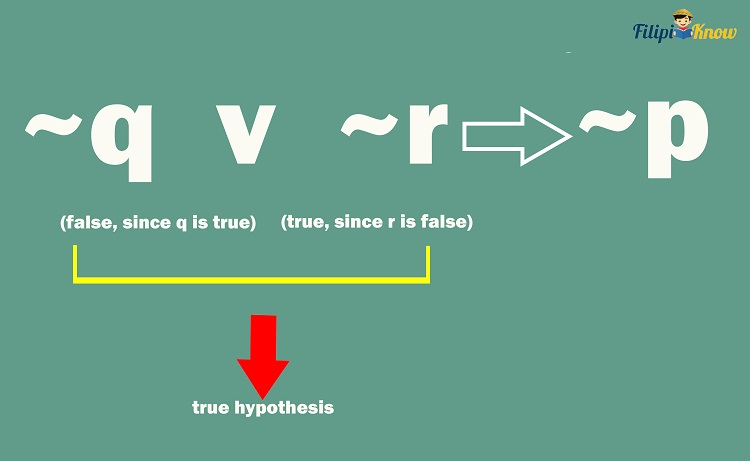
Meanwhile, we have already stated earlier that p is true. Therefore, ∿ p must be false. Thus, we have a false conclusion in the logical implication.
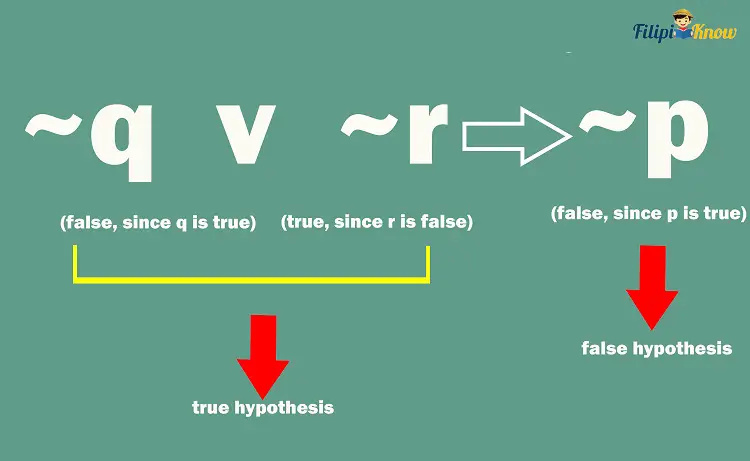
A logical implication is false if its hypothesis is true and its conclusion is false. Therefore, ∿ q ∨ ∿ r ⇒ ∿ p is a false statement.
(2) p ∧ ∿ r ⇔ ∿ q
p is a true statement, while ∿ r must be true since we have stated earlier that r is false. Thus, the conjunction p ∧ ∿ r must be true since both p and ∿ r are true. This means that the left side of the biconditional p ∧ ∿ r ⇔ ∿ q is a true statement.
Meanwhile, we have stated earlier that q is a true statement. This means that ∿ q must be false, and the right side of the biconditional statement is false.
Recall that when the sides of a biconditional have equal truth values, the biconditional is true. Since the left of p ∧ ∿ r ⇔ ∿ q is true and the right side is false, then it follows that the biconditional statement is false.
Hence, the answer is false.
You might have realized that it requires a lot of brute force and concentration to identify the truth values of complex propositions. However, you will learn how to use truth tables in the next reviewer. A truth table is a convenient tool for identifying the truth value of complex propositions.
Converse, Inverse, and Contrapositive of a Conditional Statement
We have learned earlier that a conditional statement is formed using the words “If” and “then” or the connective ⇒. In a conditional statement (or logical implication), the second statement (called “conclusion”) is a logical consequence of the first statement (called “hypothesis”). Recall also that a conditional statement is false if the hypothesis is true and the conclusion is false. Otherwise, the conditional statement is true.
Conditional statements are widely used in mathematics, especially when we want to state how certain conditions lead to a mathematical conclusion.
Let’s use the conditional statement “If a geometric figure is a square, then the geometric figure is a quadrilateral” as an example. In the first statement, “If a geometric figure is a square,” we state a specific condition of the geometric figure. From this condition, we conclude logically using the second statement, “then the geometric figure is a quadrilateral.”
Sample Problems: Translate the following statements as conditional statements.
- An even number is divisible by 2.
- Two even numbers have an even number sum.
- A positive integer has a nonnegative square.
Solution:
- If a number is even, then it is divisible by 2.
- If two numbers are even, then their sum is even.
- If an integer is positive, then its square is nonnegative.
In this section, we’ll define a conditional statement’s converse, inverse, and contrapositive. These statements are also used widely in mathematics, just like the conditional statement.
1. Converse
“The converse of a conditional statement p ⇒ q is q ⇒ p.”
The converse of a conditional statement is formed when you interchange the hypothesis and the conclusion.
For instance, “If a number is even, then it is divisible by 2” would be “If a number is divisible by 2, then the number is even.”
Another example: The converse of “If an integer is positive, then its square is nonnegative” is “If the square of a number is nonnegative, then the integer is positive.”
It is important to note that if a conditional statement is true, it’s not always the case that the converse is true.
For instance, the conditional statement “If a number is even, then it is divisible by 2” is true. Its converse, “If a number is divisible by 2, then the number is even,” is also true.
Meanwhile, although the conditional statement “If an integer is positive, then its square is nonnegative” is true, its converse “if the square of a number is nonnegative, then the integer is positive” is false since 0 is a non-negative number. Still, its square is not positive (02 = 0).
Remember, even if the conditional statement is true, there are instances where its converse is false.
2. Inverse
“The inverse of a conditional statement p ⇒ q is ∿ p ⇒ ∿ q.”
The inverse of a conditional statement is formed by taking the respective negation of its hypothesis and conclusion.
For example, the inverse of the conditional statement “If a number is even, then it is divisible by 2” would be “If a number is not even, then it is not divisible by 2.” We can also write the inverse this way: “If a number is odd, then it is not divisible by 2”.
Here are a few more examples:
The inverse of the conditional statement “If an integer is positive, then its square is nonnegative” is “If an integer is nonpositive, then its square is negative.”
The inverse of the statement “If the company earns more than ₱1,000,000 this year, then it will hire more employees” is “If the company earns less than ₱1,000,000 this year, then it will not hire more employees.”
3. Contrapositive
“The contrapositive of a conditional statement p ⇒ q is ∿ q ⇒ ∿ p.”
The contrapositive of a conditional statement is formed by negating the hypothesis and the conclusion and then interchanging their position (i.e., the negated hypothesis becomes the new conclusion while the negated conclusion becomes the new hypothesis).
Here are the steps you have to follow to form the contrapositive of a conditional statement:
- Negate the hypothesis of the conditional statement.
- Negate the conclusion of the conditional statement.
- Make the statement you have derived in Step 2 the new hypothesis, while the statement you have derived in Step 1 is a new conclusion.
Sample Problem 1: Form the contrapositive of the conditional statement “If a whole number is even, then it is divisible by two.”
Solution:
Step 1: Negate the hypothesis of the conditional statement.
The hypothesis of the conditional statement is a whole number is even; the negation of this statement is “a whole number is not even” or “a whole number is odd.”
Step 2: Negate the conclusion of the conditional statement.
The conclusion of the conditional statement is “it (the whole number) is divisible by 2.” This statement is negated as “it is not divisible by 2.”
Step 3: Make the statement you have derived in Step 2 the new hypothesis, while the statement you have derived in Step 1 the new conclusion.
We use the negated hypothesis as the new conclusion and the negated conclusion as the new hypothesis. Therefore, we have: “If a whole number is not divisible by 2, then it is not even.”
Sample Problem 2: Form the contrapositive of “If a triangle has a right angle, then it is a right triangle.”
Solution:
Step 1: Negate the hypothesis of the conditional statement.
- Hypothesis: A triangle has a right angle
- Negated hypothesis: A triangle has no right angle
Step 2: Negate the conclusion of the conditional statement.
- Conclusion: It is a right triangle
- Negated conclusion: It is not a right triangle
Step 3: Make the statement you have derived in Step 2 the new hypothesis, while the statement you have derived in Step 1 the new conclusion.
- Original statement: “If a triangle has a right angle, then it is a right triangle.”
- Contrapositive: “If a triangle is not a right triangle, then it has no right angle.
Next topic: Truth Tables and Logical Equivalences
Previous topic: Basic Integration
Return to the main article: The Ultimate Basic Math Reviewer
Download Printable Summary/Review Notes
Download Printable Flashcards
Test Yourself!
1. Practice Questions [Free PDF Download]
2. Answer Key [Free PDF Download]
3. Math Mock Exam + Answer Key
Written by Jewel Kyle Fabula
Jewel Kyle Fabula
Jewel Kyle Fabula graduated Cum Laude with a degree of Bachelor of Science in Economics from the University of the Philippines Diliman. He is also a nominee for the 2023 Gerardo Sicat Award for Best Undergraduate Thesis in Economics. He is currently a freelance content writer with writing experience related to technology, artificial intelligence, ergonomic products, and education. Kyle loves cats, mathematics, playing video games, and listening to music.
Copyright Notice
All materials contained on this site are protected by the Republic of the Philippines copyright law and may not be reproduced, distributed, transmitted, displayed, published, or broadcast without the prior written permission of filipiknow.net or in the case of third party materials, the owner of that content. You may not alter or remove any trademark, copyright, or other notice from copies of the content. Be warned that we have already reported and helped terminate several websites and YouTube channels for blatantly stealing our content. If you wish to use filipiknow.net content for commercial purposes, such as for content syndication, etc., please contact us at legal(at)filipiknow(dot)net